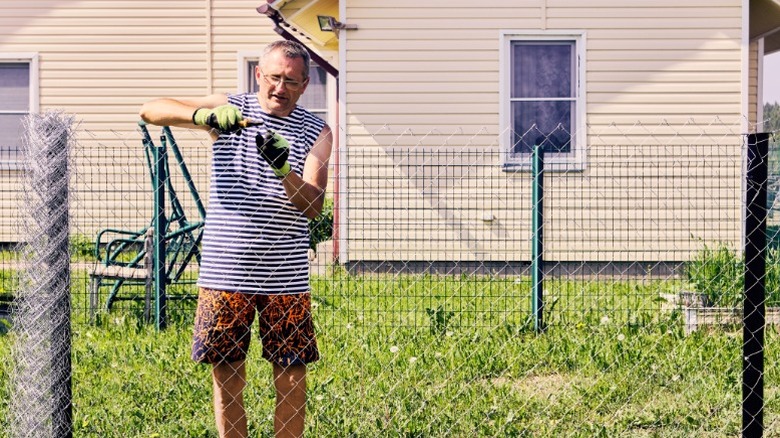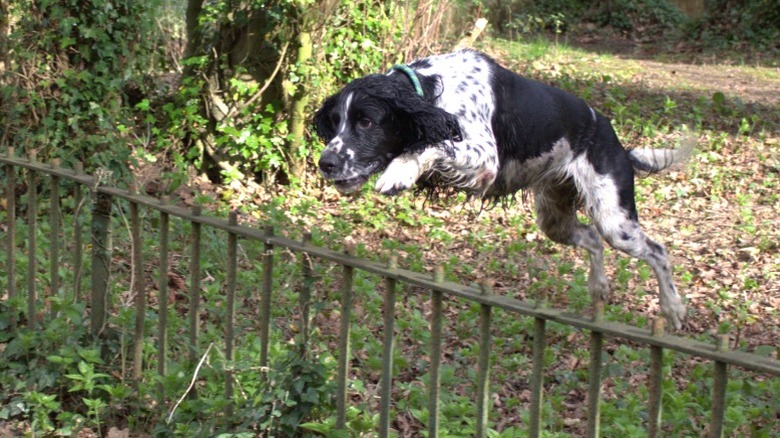DIY A Temporary Dog Fence To Keep Your Furry Friend Safe Until You Can Upgrade
We may receive a commission on purchases made from links.
Even though you and your dog may be chomping at the bit for backyard activities, setting up a dependable fence is one prep step you have to knock out before you enjoy even a second of outdoor playtime off-leash. Letting our dogs wander off or another animal wander in for an unsafe encounter are scenarios no owner wants to experience and ones an unbroken barrier can easily prevent. But in many cases, installing a fence is far easier said than done. Generally starting around $1,800 to install, fences can be cost-prohibitive, especially in larger areas. Plus, some yards don't have clearly defined boundaries, making it difficult to decide on a long-term solution, or are home to renters who don't have permission to build a permanent fixture.
When you're facing issues like these but want to give your dog outdoor enrichment as soon as possible, an affordable fence for the yard in a temporary construction is the clear solution. Investing in a dog playpen like the multipanel BestPet Dog Playpen can a great portable option to set up a safe play area in a matter of minutes, but pens like this aren't large enough to give all dogs the space needed to get out their zoomies. Building a temporary fence gives you more options to get the height, size, and shape you want while also saving you money in many cases. With a few considerations around your dog's specific needs, you can lay out an effective temporary fence in only a few hours. Using wire mesh fencing, all you need are some T-posts or rebar and PVC for an upgraded look.
How to set up your DIY temporary dog fence
A temporary dog fence doesn't have to be complicated or expensive. For a basic yet reliable design, use studded T-posts (e.g., Thealyn 6-foot metal posts) and a mesh fencing roll, such as FOREHOGAR vinyl-covered wire fence. Use a string line to line up your posts around the fenced area. Space the posts 8 to 12 feet apart, and drive them until the anchor plate is well-established in the ground. To make it easier to push the posts into the ground, consider getting a fence post driver. If possible, you can place posts next to trees and other fixed supports, tying them together to improve the fence's support. Run your fence between the posts, stretching it tight as you lock the sections into the notches. Secure the fencing to the posts with zip ties.
You can also DIY your fence supports, as the creators Mother Daughter Projects DIY did on YouTube for their temporary construction. Using ½-inch rebar supports as stakes, they fitted green-painted ½-inch PVC pipes over the rebar to make sturdy fence posts. After installing your fence, you can also lay pavers, wood sleepers, or other weighted items over the fence's bottom edge to discourage your dog from going under the fence. With a little imagination, you can find a DIY fence solution that can work with your budget and skill set.
What to consider to make your temporary fence work for your dog
A basic dog-proof fence can work for dogs that don't typically run off, but some can be true escape artists. Maybe you have a terrier that burrows, a border collie that can easily vault a 4-foot fence, or a German shepherd that will run through anything to chase after squirrels. Whatever the case, many dogs need extra considerations to contain them. It may help to dissuade your pet from bursting through the fence in the first place. A visual cover, such as landscaping fabric, over the fence can block stimuli on the other side. Without being able to see cats, squirrels, or other dogs beyond the fence, pets may be less likely to get agitated and attempt an escape.
If your dog likes jumping fences, choosing a taller 5-foot or 6-foot fence is ideal, while diggers need obstructions around the fence's base. An effective solution can be to dig a trench and lay mesh into it, running it down the fence and curving it in an L shape so it runs along the trench in front of the fence. Fill the trench back in with soil, and your dog will run into it if they try digging underneath. Otherwise, a key consideration for larger dogs is to choose the right temporary fence material, like rigid metal wire, that can withstand their weight and any attempts at barreling through it. Although a temporary fence is rarely 100% dog-proof, a combination of appropriate features like these and quality dog training can make your DIY temporary dog fence perfectly suitable for your needs.


